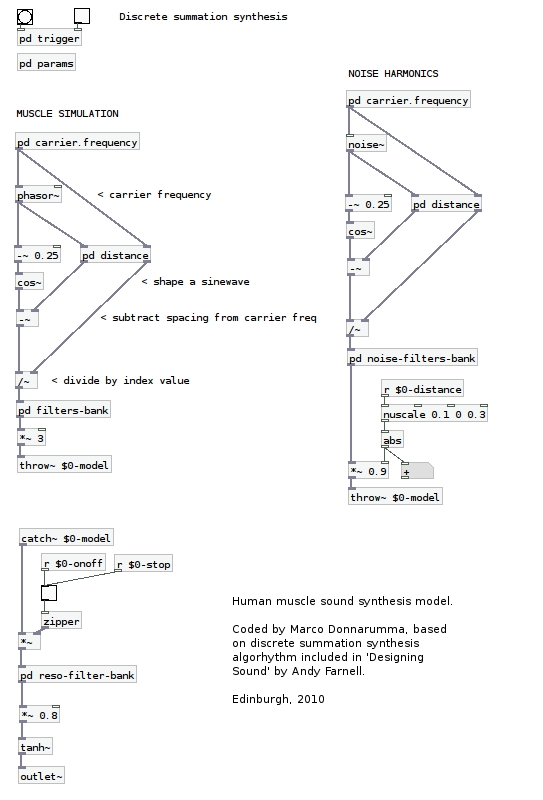An audio synthesis model for muscles sounds
While waiting for the components I need to build the bio-sensing device, I started coding a synthesis model for human muscle sounds.
I illustrate below the basis of an exploratory study of the acoustics of biologic body sounds. I describe the development of an audio synthesis model for muscle sounds which offers a deeper understanding of the body sound matter and provides the ground for further experimentations in composition.
I’m working with a machine running a Linux OS and the audio synthesis model is being implemented using the free, open source framework known as Pure Data, a graphical programming language developed by Miller Puckette. I’ve been using Pd for 4/5 years for other personal projects, thus I feel fairly comfortable working in such environment.
Firstly, it is necessary to understand the physical phenomena which makes muscle vibrate and sound.
As illustrated in a previous blog post, muscles are formed by several layers of contractile filaments. Each of them can stretch and move past the other, vibrating at a very low frequency. However audio recordings of muscle sounds show that their sonic response is not constant, but sounds more similar to a low and deep rumble. This might happen because each filament does not vibrate in unison with each other, but rather each one of them undergoes slightly different forces depending on their position and dimension, therefore each filament vibrates at a different frequency.
Eventually each partial (defined here as the single frequency of a specific filament) is summed to the others living in the same muscle fiber, which in turn are summed to the other muscle fibers living in the surrounding fascicle.
Such phenomena creates a subtle, complex audio spectra which can be synthesised using Discrete Summation Formula. DSF allows the synthesis of harmonic and inharmonic, band-limited or unlimited spectra, and can be controlled by an index, which seems perfectly fitting the requirement of this acoustic experiment.
Currently I’m studying the awesome book “Designing Sound” by Andy Farnell (MIT Press) and the synthesis model I’m coding is based on the Discrete Summation Synthesis explained in Technique, chapter 17, pp. 254-256.
I started implementing the basic synthesis formula to create the fundamental sidebands, then I applied DSF to a noise generator to add some light distortion to the sinewaves by means of complex spectra formed by tiny, slow noise bursts. Filter banks have been applied to each spectra in order to refine the sound and emphasise specific harmonics.
Eventually the two layers have been summed, passed through another filter bank and a tanh function, which add a more natural characteristic to the resulting impulse.
Below a screenshot of the Pd abstraction.
Next, by applying several audio processing techniques to this model I hope to become more familiar with its physical composition and to develop the basis for a composition and design methodology of muscle sounds, which will be then employed with the actual sounds of my body.


